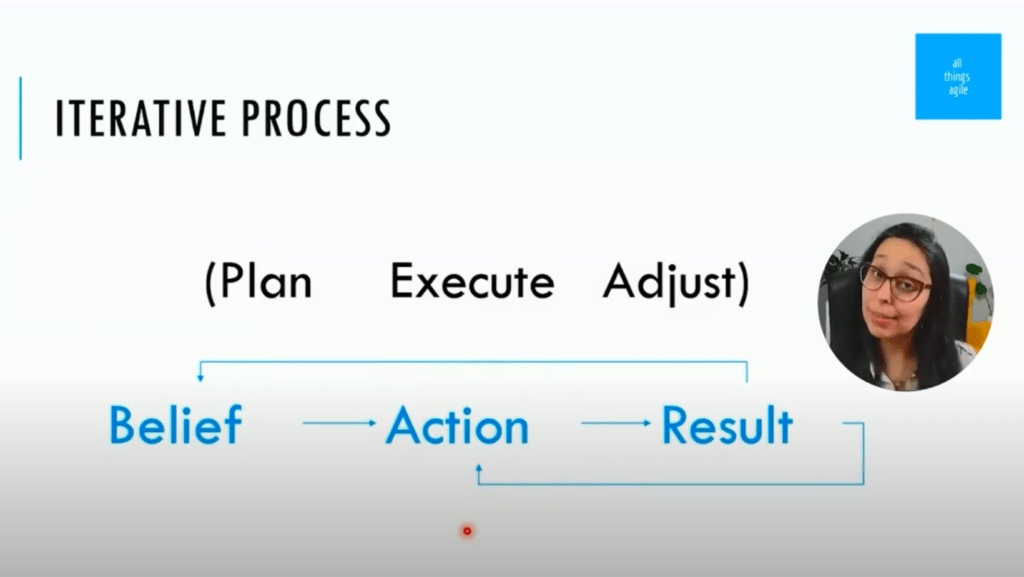
As Agile Coaches and Scrum Masters, we all want to guide our teams to be successful and high performance. But what does the path to success even look like? And what can we do to help them on this road? What is our role?
If you’d rather watch a video than read, check out my youtube video on this topic:
Table of Contents
ToggleThe success path for agile teams
Although there is a basic success path that we can follow, we are all unique, and for that reason this path is more of a guideline. Use each as a stepping stone to figure things out for your individual team.
Step 1: Trust
Trust is foundational but it’s not a binary thing, it’s a scale. You grow in your level of trust so it’s something you will have to constantly work on. Conducting a single team building session won’t get you there. Trust is influenced with every interaction so always act with integrity and be reliable. It is important that the team knows who its members are and who they can rely on. Teams also need to trust their managers, other teams, and their stakeholders. Trust is all encompassing.
Step 2: Know the technology
The team needs to master their technology and engineering practices that are inherent to their industry. It’s even a principle of agile: technical excellence. Focus on growing the knowledge of the team members. Think about it: if you are a new runner, your first run will be terrible. Once you learn the right training schedule, diet, lifestyle, attire, etc. (aka the technologies of running), you’ll become great.
Step 3: Define success
The team has to know and understand the mission clearly, as well as their role in achieving that mission. Have clear boundaries and expectations for where the team wants to go and how they are going to get there.
Step 4: Love to measure
In order to achieve the mission, we need to measure along the way, to attest progress. And measure the right thing. But keep in mind that numbers will change depending on the situation and measures will evolve over time and context. For example, when you learn to play piano, you may measure your ability based on how fast you can play your scales. Five years on, this measure isn’t useful to you anymore. Instead you might measure your ability based on your tone, emoting, interpretation, etc.
Step 5: Become good at iterating
Iterating is at the heart of agile and at the end of iterations, we are always learning. We learn on the personal, product, and ways of working levels. This is a great spot for you to show up as a coach. During the retrospective, don’t get caught up in making fun and funky boards. Instead, keep them practical by bringing powerful questions and data that promote learning.
The iterative process (plan, learn, adjust) is what agile is built on and the adjust part of this is crucial. Learning has to be applied. The adjustment can be small, but create the space for your team to do it. It can happen every day, at the end of a sprint, or at the end of an iteration, but it is continuous improvement.
But we don’t want to only adjust our actions, we also want to adjust the beliefs and assumptions we use for doing things. This is called double-loop learning. You will produce more consistent results when you believe and understand why you are changing your action, instead of just changing your action. For example, you can implement a rule for your teams that you can’t have more than 3 stories, but once they see and understand why it is important to not accept too much work, it will be much more effective. The double loop allows for your results to inform your actions and beliefs.

Remember though that this iterative process is built upon trust. When teams trust that their manager will remove any blockers, they can plan properly. When teams know that the stakeholders selected the right priorities, they can make decisions easily.
Agile pitfalls
Along this success path, there are potential pitfalls that can happen when things are not calibrated.
Watch out for these kinds of teams:
- The team cupcake. This kind of team occurs when there is trust but nothing is measured. There may be great interactions and high morale but because they don’t measure, they think things are better than they really are and thus, don’t need any improvement. This lack of measurement can also be a form of armor in cases where there is high trust within the team, but a lack of trust with managers, stakeholders, etc. They may not be measuring as a protective way to not expose themselves. Understanding this can help you as a coach course correct.
- The team waterfall. This kind of team occurs when there is trust and a clear goal, but no one understands the iterative plan and execution. As a result, they never learn, adjust, and change their assumptions. This can lead to problems with delivery due to a lack of flexibility and adaptability.
- The team fast and furious. This kind of team happens when there is trust but no clear definition of success. They are going fast on the road to nowhere. This can lead to issues with delivering the wrong thing.
As a coach, the best way to avoid pitfalls like this is to take a close look at your teams and see what aspects on the path to success may be off balance.
What you can do as a coach
Fostering a successful Agile team isn’t all about changing the team. Instead, think about how you can show up as a coach!
Effective coaches take on different stances or postures depending on what fits in the context or situation. The stances of an agile coach include: facilitating, coaching, transformational acumen, technical acumen, business acumen, mentoring, and teaching. I also like to add EQ to this equation to help you get in-tune with your team and judge which stance the situation requires.
Instead of just re-telling your team the information that you’ve learned, focus on listening and determine from there how you need to adapt your stance. Practicing offering, inviting, and co-creation can help you avoid too much telling.
Remember, your role as a coach is to facilitate the iterative work. Ask yourself:
- How do I help my team plan effectively?
- How do I help my team keep focus and detect deviations from the plan?
- How do I help my team grow through applied learning?
- What can I do to exemplify and amplify trust in my team?
Also, consider framework neutral agile. The best framework for your clients is the one that they create and you can help them do that. Scrum is great, but doesn’t work everywhere. Meet your teams where they are. If they already have some system in place, go with that. Work with them.
If they don’t have any idea where to start however, Scrum is easy and free to experiment with.
Whether this is your first time with Scrum or maybe your first time coaching your team into agile, you could benefit from a simple playbook. My book Scrum in Practice is exactly that. With simple explanations and guiding questions you should be able to experience agile safely with your team in no time.




